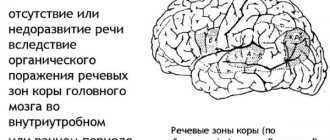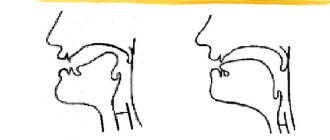Home — About speech therapy — At an appointment with a speech therapist. Producing sounds in adults.
The most common reason for contacting a speech therapist is incorrect sound pronunciation. Of course, “r” and “r” can easily be called “favorite” sounds for work. Not all children learn to pronounce words correctly on their own, and some of these children grow up to be adults who have not received speech therapy help. A slight French accent with a throaty “r”, replacing sounds with another (most often “l”) or simply omitting a hard-to-pronounce sound distorts speech and attracts the attention of others.
Of course, nothing can be fixed. Look, Edward Radzinsky even appears on TV, creates original programs and is generally a very respected person. And anyone else can live and build a career without pronouncing not only “r” and “r”, but also half of the other sounds. (“L”, “l”, “s”, “z”, “ch” are also frequent “guests” at speech therapist appointments). But the point is not at all how you can, but what you want. Due to incorrect sound pronunciation and unclear speech, many become embarrassed to express themselves, speak in public, and lose confidence. When deciding whether to go to a speech therapist or not, you should ask yourself the question: do I need it? Do I really want to improve my speech?
The question is also important because not only a specialist will be involved in producing sounds. You will need a desire to change your speech, active participation and the desired completion of homework. These are prerequisites for correcting pronunciation. And you will understand this yourself when you have a little idea of the work process.
Setting sounds [L], [L]
A set of exercises for the sounds L, L: “needle”, “fast snake”, “turkey poults”, “dipper”, “horse”, “painter”, “woodpecker”, “steps”, “steamer”, “hunter”.
Methods and techniques for producing the sounds L, L..
If there is no sound, production is carried out in 2 stages:
- Setting [l] interdental. The child is asked to pronounce the combination ya. In this case, [s] is pronounced briefly, with tension in the organs of articulation, then pronounce the combination with the tongue stuck between the teeth. When the sound becomes clear, it is necessary to slow down the movement of the lower jaw. In children with an erased form of dysarthria, it is recommended to fix this sound in syllables and words.
- Next, move the tongue to the tooth position, pressing the tongue firmly against the alveoli and pronounce ly-ly-ly.
With nasal pronunciation, production is carried out in the same way as in the absence of sound. First of all, it is necessary to develop the correct direction of the air stream.
Setting the sound [L] during interdental pronunciation. If a child pronounces several groups of sounds this way, special attention is paid to the development of motor skills of the tip of the tongue. The performance is carried out as in his absence. You can use mechanical assistance - use a spatula to lift the tongue by the upper incisors and hold it until this position is fixed in the child.
Setting the sound [L] when replacing [l] with the sound [th].
When replacing [l] with the sound [th], with the mouth open, place a round plastic tube on the middle part of the back of the tongue, and lift the tip of the tongue by the upper incisors.
When replacing the sound [L] with a soft sound [l], you can use probe No. 4. Ask the child to repeat the syllable [la] several times, then insert the probe so that it is between the hard palate and the middle part of the back of the tongue. Press the probe down on the tongue (to the right or left). To lower the middle part of the back of the tongue, you can perform the following exercise: rest your tongue firmly on the upper incisors and pronounce the syllable ky several times. Then sharply open your mouth (you can help by pressing on your chin). This technique is not suitable for children with lateral pronunciation.
When pronouncing [a], you need to “knock” your tongue on the upper incisors. The exhalation should be hot, smooth and continuous.
In some cases, a faster and clearer sound is obtained in the reverse syllable. Pronounce [a] for a long time, then “bite” the tip of the protruding relaxed tongue: [aaall-aaal-aallaallaaa].
From the sound [v] is placed in a mixed way. Ask the child to pronounce the syllable you with his tongue inserted between his lips, then push back the lower lip with your finger.
A similar technique can be used from the combination [bl] (“turkey”). While pronouncing the combinations blblbl, gradually move your lips to the sides and your tongue deep into your mouth (first along the lips - [blblbl], then along the upper teeth and then along the alveoli).
Invite the child to put as much tension as possible in the shoulder girdle area, for which you need to bend your head forward and in this position, sound the sound [l] as low as possible.
Using two fingers - index and ring - apply light pressure on the outside of the neck so that each finger is at a point at the inner edge of the posterior third of the left and right branches of the lower jaw.
When pronouncing a sound from the side, you must first achieve the correct air flow and straight position of the tongue. The child should be switched from incorrect articulation. Methods No. 1, 8,9 are suitable for this.
The main difficulty in producing the sound [L] is that while pronouncing the sound correctly, the child continues to hear his previous sound. Therefore, it is necessary to attract the child’s auditory attention to the sound that is produced at the moment of its production.
Causes of speech disorders in children
A child’s speech can be delayed at any stage of its development for a variety of reasons. Such children often have a poor vocabulary that is not appropriate for their age group. The development of phrasal speech is somewhat delayed, and defects in the pronunciation of sounds persist for a long time.
One of the reasons for such a temporary delay in speech development may be various diseases suffered by the child at an early age. Speech development is greatly influenced by gastrointestinal diseases, as a result of which the nutrition of the whole body and the cerebral cortex is disrupted.
Speech disorders can also be caused by:
- fetal infection;
- lack of fetal oxygen;
- Rhesus conflict;
- risk of miscarriage;
- toxicosis;
- chronic high or low blood pressure in a pregnant woman or other diseases of the cardiovascular system;
- fall of the expectant mother, resulting in injury to the fetus;
- bad habits of a pregnant woman (smoking, alcohol, drugs);
- complex labor (including transient, protracted) or childbirth that began ahead of schedule;
- if obstetric instruments were used during childbirth;
- intracranial birth injury in a newborn;
- received traumatic brain injury from birth in early childhood;
- jaundice in a newborn (nuclear);
- genetic predisposition (one of the parents has a history of a disease associated with speech impairment);
- a child under 3 years of age often suffered from acute respiratory viral infections, pneumonia, rickets and other diseases;
- the baby underwent surgery using general anesthesia;
- a preschooler grows up in unfavorable social conditions;
- the child is diagnosed with cerebral palsy;
- the tongue or upper lip has a short frenulum;
- malocclusion, abnormal structure of the dentition or palate;
- The child has not developed phonemic hearing.
Among the etiological factors, social reasons can also be identified. If adults speak hastily, tongue-tied, dialectally, then the child will imitate them.
When the child is not engaged, then the preschooler is left to his own devices: he does not hear correct speech, they do not communicate with him, as a result of which he withdraws into himself, speaks little and poorly. If a family alternately speaks two languages, this can lead to speech impairment (dyslalia).
Setting sounds [Р], [Рь]
A set of exercises for the sounds Р, Рь:
- "needle",
- "fast snake"
- "turkey poults"
- "bucket"
- "horse"
- "painter",
- "woodpecker",
- "steps"
- "drummer",
- "balalaika".
Methods and techniques for producing sounds [P], [Pb].
By imitation.
The child is asked to perform the “mushroom” exercise. At the moment of suction, ask to blow forcefully on the tip of the tongue. A voice is added to the resulting dull vibration.
When the upper elevation of the tongue is set, the child is asked to pronounce the combinations: jzhzh, zhzhzh, or d-d-d-d. At this point, use a spatula, ball probe or clean finger to make quick movements from side to side along the bottom of the tongue closer to the tip.
For spasticity of the tongue root, this technique is used while lying down.
In a similar way, you can call [P] from [Z] the upper rise. The child is asked to hold his tongue at the base of the upper teeth and pull out the sound [З] for a long time. During its pronunciation, the tip of the tongue is in a more tense state and the air stream is more forced. The resulting sound is not clear, but rather noisy. The resulting sound mechanically causes a trembling [P].
When pronouncing [P] in the throat, the production takes place in 2 stages.
Setting up a single-strike [P] from the sound [Zh]. When pronounced in a drawn-out manner, without rounding the lips, moving the tongue slightly forward, towards the gums of the upper teeth. In this case, the sound is pronounced with significant air pressure and a minimal gap between the front edge of the tongue and the gums. Then the placement is carried out using a probe as in other cases.
The most common technique is the production of [D], repeated on one exhalation, followed by a more forced pronunciation of the latter.
When pronouncing the combination [tdtdtdtd] repeatedly, with the mouth slightly open and when the tongue is closed with the gums, vibration occurs. However, this method is not suitable for correcting velar or velar [P].
When the mouth is closed with teeth tightly clenched, sometimes in combination [tr] a voiceless [r] (prodental) is heard. You can make a sound from it if, while pronouncing this combination, you gradually open your mouth, pushing a spatula between your teeth.
To maintain the upper elevation of the tongue, use the “turkey poult” exercise. When quickly pronouncing the combination [blblbl], the lower lip is first lowered (the tongue moves along the upper), then the movements are transferred to the upper incisors, and then to the alveoli. This sound turns out to be slightly burry. To eliminate this defect, you should ask the child to fixate a strong exhalation on the sound d.
If the child does not maintain the upper position of the tongue, and the sound comes out dull and not booming, you can ask the child to “extend” the sound – drn – drn (“start the car”).
Setting sounds [Ш], [Ф], [Ч]
A set of exercises for producing the sounds Ш, Ж, Х:
- "bowl",
- "delicious jam"
- "fungus",
- "harmonic",
- "horse"
- "focus",
- “punish the disobedient tongue.”
Methods and techniques for producing sounds [Ш], [Х], [Ч].
By imitation.
Sound [Ш]. Ask the child to lift his tongue with a scoop over his upper teeth. While holding this position, pronounce the sound [s], paying attention to the fact that the sound [sh] is heard.
The child pronounces the syllable [sa] several times, and the speech therapist gently raises the tip of the tongue with a spatula or probe towards the alveoli. Then you need to blow strongly on the tip of your tongue, adding the sound [a] to the exhalation.
When the sound r is intact, the child pronounces the syllable [ra], and at this moment the speech therapist touches the lower surface of the tongue with a spatula or probe to slow down the vibration. Or they ask you to pronounce the sound [r] as quietly as possible.
When pronouncing the sound x, which produces a strong air stream, the child is asked to raise his wide tongue to the alveoli. However, so that the resulting sound does not remain rear-lingual, it is necessary to focus on the tip of the tongue.
If, when the tongue is raised, its lateral edges are not adjacent to the upper molars, then the thumbs of both hands press it on both sides. Or, standing behind the child, insert the index and middle fingers under the tongue and ask to blow on the tip of the tongue.
The child pronounces the sound [t] ([d] for the sound [zh]) for as long as possible, holding the tongue behind the upper teeth. The resulting sound is close to noisy [s]. Then the speech therapist uses a spatula to slightly move the tongue towards the alveoli. The same technique can be used if the child pronounces the sound [h].
The sound [zh] is placed similarly, but with the inclusion of voice.
The sound [h] is easier to place in reverse syllables. To do this, ask the child to pronounce the syllable [at] with a strong exhalation on [t], while slightly stretching his lips forward, and control the exhalation with the palm of his hand.
If a child has the sound [sch], then you can put [ch] from it if the child quickly begins to pronounce the combination [tsch].
From the sound [ts], at the moment of its pronunciation, ask the child to raise the tip of his tongue upward and stretch his lips forward.
In some cases, it is possible to place [h] from the combination [ts]. To do this, fix your lips in the “horn” position and pronounce the combination “like a shot” with a strong exhalation. If the tongue does not rise, use mechanical assistance - a spatula, a probe.
The sound [ш] is placed in imitation of the sound [h] - stretching it out, or from [sh], moving the tongue to the base of the upper teeth.
From the sound [zh], pronouncing it in a whisper.
From the sound [sya] mechanically, lifting the tongue up or showing.
Setting the sounds S, Сь, З, Зь, Ц.
A set of exercises: “spatula”, “punish the naughty tongue”, “brushing teeth”, “the train whistles”, “strong tongue”, “swing”, “angry kitty”, “groove”.
English paired consonants /b–p/
Now let's talk about the promised lack of stunning/voicing of sound. In Russian there are processes:
- when a voiceless sound is in front of a voiced sound, it also becomes voiced: To p desyatka /to bd'is'atk /,
- when a voiced sound comes at the end of a word, it becomes voiceless: oak /dup/.
In English, the voiceless /p/ is not voiced when placed before a voiced sound: stop B
ob /stɒ
p b
ɒb/.
And the voiced /b/ is not devoiced in final position. It becomes weaker and shorter, but remains VOID! Otherwise, you can change the meaning of the word: cab (taxi) – cap (lid)
.
Listen to Chris Rock say club
.
We stay in the club b . We live in the club b . We die in the club b . We get our car washed in the clu b . We go to school in the club b . We go to the cleaners in the clu b .
From the very beginning of the video
EXERCISE.
Here are words ending in /b/ and /p/. Say them according to the transcription, without deafening the /b/ sound at the end. Remember that the sound /b/ becomes weaker and /p/ is pronounced with partial aspiration.
cu b
/kʌ
b / cu p
/kʌ
p /
li b
/lɪ
b / li p
/lɪ
p /
pu b
/pʌ
b / pu p
/pʌ
p /
ro be
/rəʊ
b / ro pe
/rəʊ
p /
ta b
/tæ
b / ta p
/tæ
p /
ca b
/kæ
b / ca p
/kæ
p /
ri b
/rɪ
b / ri p
/rɪ
p /
bu b
/bʌ
b / bum p
/bʌm
p /
clu b
/klʌ
b / clum p
/klʌm
p /
When you have mastered all the details of correct pronunciation, consolidate the result with tongue twisters.
For the sound /b/
- A B ritish b uilder b uilt a b uilding of b rown b ricks. A B ulgarian b uilder b uilt a b uilding of b lack b ricks.
- A b ig b lack b ug b it a b ig b lack b ear, a b ig b lack b ear b it a b ig b lack b ug.
- B etty's b a b y's name is B ar b y. B etty's B ar b y is a b ad- b ad b oy. B aby B ar b y is a b ad b ad b aby. B etty b ought a b right b lue b lanket for her b a b y- b oy.
For the sound /p/
- P retty P olly P erkins has a p air of p retty p laits.
- P eter P i p er p icked a p eck of p ickled p e p p er, a p eck of p ickled p e p p er P eter Pi p er p icked. If P eter P i p er p icked a p eck of p ickled p e pp er, where's the p eck of p ickled p e pp er P eter P i p er p icked?
- P ablo P icasso p ut off his p alette, p aintbox and p aintbrushes. And painted with p en a pic ture of a p eaceful p lace in P aris. With a p ink p alace and a p aled p ark p lenty of p retty p lants. What's the p ossible p icture 's rice?
Methods and techniques for producing sounds [С], [Сь], [З], [Зь], [Ц]
In cases of dental sigmatism, it is sufficient to lower the tip of the tongue to the lower teeth with mechanical assistance and thus obtain a gap instead of a bow.
In labial-dental pronunciation, it is necessary to inhibit the participation of the lips, for which preparatory articulation exercises are carried out. Or slow down the movement of your lips with your finger.
In other cases, the child is asked to smile, pulling the corners of the mouth so that the teeth are visible, and blow on the tip of the tongue to produce a whistling sound.
The child is asked to pronounce the syllable ta repeatedly, the speech therapist inserts probe No. 2 or a ball probe between the alveoli and the tip of the tongue (as well as the front part of the back of the tongue) and presses down lightly.
With interdental sigmatism, you need to pronounce the syllable [sa] with clenched teeth at the beginning of its pronunciation or slightly lengthen the pronunciation of the consonant, and lower the jaw on the vowel a.
For lateral sigmatism, a two-stage placement technique is used: they cause interdental pronunciation to get rid of the squelching noise, and then move the tongue to the interdental position.
In some cases, with isolated nasal sigmatism, the sound is placed from the sound [F]. By pushing the tongue between the teeth and moving the lips away with mechanical assistance.
Pronunciation of the combination [ee] or [th] with tension prepares the desired form of the tongue and produces a concentrated air stream.
Similar to the sound [x]. Lips in a smile, teeth in the form of a correct bite (slightly closed). Ask the child to pronounce the sound [x] “into the teeth” and feel the cool air stream with his palm.
The child is asked to pronounce the sound [T] with a strong forced exhalation. The resulting noisy sound (close to [Ts]) should be stretched out as long as possible. It is necessary to monitor the position of the lips in a smile and control the force of the air stream with the palm of your hand.
An equivalent method of staging from the sound [ts]. By lengthening and adjusting the strength of the sound pronunciation, a clear [s] is achieved: TSSSSssssssss.
A very rare technique of staging while inhaling . Place a wide tongue at the bottom of the mouth so that it is in contact along the entire perimeter with the lower teeth. Stretch your lips into a smile, teeth slightly closed in the form of a correct bite. In this position, after exhaling (shoulders should be lowered), the child should “suck” very little air into himself, so little that it hits the very tip of the tongue. Next, “drive” a stream of air into and out of the mouth. At first, the exercise is performed at a fast pace, then, if the sound is clear, slow down the pace.
From the sound [sh] by imitation or mechanically, slowly moving the tongue forward to the upper teeth, then down. The teeth should be closed.
The sound [Sj] can be placed from [S] in combination [isi] with the highest possible sound [ii] at a fast tempo.
Similar to the production of [s] from the sound [Хь].
The sound [З] (зь) is placed in the same way as [s] (сь), but with the voice connected. In cases where the sound [z] still turns out to be dull, it is pronounced between two consonants - [mzm]. Draw out the sound [m] as long as possible, and pronounce the sound [z] (s) quickly.
The sound [Ts] is made from a combination of [t] and [s] or from [t] at a fast pace with a forced exhalation on [t]. However, the sound in the reverse syllable is better - [ats].
[Ts] from the sound [h] by imitation, stretching your lips as much as possible in a smile.
Sound setting [Y]
Set of exercises:
- "Let's brush our teeth"
- "needle",
- "slide",
- "coil",
- "tongue is strong."
Methods and techniques for producing sound [Y].
It is often possible to create a sound by imitation. It is useful to add the display of articulation and the tactile sensation of the expiratory stream during prolonged pronunciation [yyy].
The child pronounces the combination [aia] or [ia] several times. The exhalation intensifies somewhat at the moment of pronouncing [i], and immediately, without interruption, [a] is pronounced. You can put the sound immediately in words where the [th] sound is first.
The child pronounces the syllable [zya], repeating it several times. During pronunciation, the speech therapist presses the front part of the back of the tongue with a spatula, moving it back slightly until the desired sound is obtained.
When pronouncing the sound [хь] for a long time, pay attention to the very thin gap between the teeth and increased exhalation.
If the sound [th] is replaced by the sound [l], differentiation should be made by lowering the tip of the tongue down with a spatula or as shown.
Setting sounds [K], [G], [X]
Set of exercises:
- "slide",
- "coil",
- "painter",
- gargling,
- coughing.
Ways and techniques of making sounds k, g, x.
The sound [X] is made by imitation of the “let’s warm our hands” exercise. Open your mouth two fingers and blow warm air onto your palms. In some cases, tilting your head up helps.
The sound [К] (кь) is placed from the sound [т] (ть) with mechanical help. The child pronounces the syllable [ta] (tya) several times; at the moment of pronouncing, the speech therapist uses a spatula or probe to move the tongue deeper into the mouth by pressing on the front part of the back of the tongue. First one hears [ta], then [tya – kya – ka].
Sound [G]. Sometimes it’s easier to first put the sound [g] from [s]. The child throws back his head and pronounces [yyy] with a strong exhalation, while slightly pushing his lower jaw forward, lowering and raising it - “the bear growls.”
If the sound turns out to be South Russian.
It happens that even the sound [x] is pronounced without raising the back of the tongue and part of the air passes into the nose, so the air flow should be controlled by slightly pinching the nose.
The sound [X] is placed from the sounds s and w mechanically - at the moment of their pronunciation, move the tongue deeper into the mouth. The sound g is placed from the sound d in the same way as the sound k.
Staging other sounds
Sound setting [U].
Stretching your lips forward, pronounce the sound [u], then close and open your lips with your fingers. Or do the “balalaika” exercise with your fingers on your lips at a faster pace. The sound can be immediately entered into words: paper, Pinocchio, etc.
When replacing [B] with [P], you should initially teach: to distinguish sounds, to distinguish incorrect pronunciation from correct, to teach to include the voice at the stage of preparing the articulatory position.
Sound setting [B].
Stretching your lips forward, pronounce the sound u, then mechanically press your lower lip to your teeth.
Bite the edge of your lower lip, slightly stretch your lips into a smile and hum, then sharply open your mouth and say [A]. Particular attention should be paid to the duration and force of exhalation on the lower lip.
Sound setting [D].
- Pronounce the sound [B] with your tongue stuck between your teeth, then use your fingers to spread your lips.
- From the sound [Z] or [Zh]. At the moment of pronouncing, use sharp movements of the spatula to press the tip of the tongue against the alveoli.
Negative impact on child development
The following have a negative impact on the development of a preschooler:
- TV;
- gadgets (tablets, smartphones, etc.);
- unfavorable conditions (lack of educational toys, books, places for games and for drawing, modeling);
- the child does not walk outside, has poor physical skills, has no responsibilities at home, and does not know how to look after himself according to his age;
- from a psychological point of view, a comfortable atmosphere in the family is not recognized (no trust, constant screaming, insults, punishment, as a result of which the baby experiences stress, lack of attention from adults, minimal or complete absence of physical contact, especially with the mother).
A preventive factor for the normal development of a child is planning a pregnancy.
Recommendations for producing sounds for various speech disorders
Phonetic-phonemic speech underdevelopment (FFSD).
The production of sounds during FFNR is carried out with the maximum use of all analyzers. Children's attention is drawn to the basic elements of sound articulation during the period of its evocation.
The following is taken into account:
- for the initial production, sounds belonging to different phonetic groups are selected;
- sounds mixed in children's speech are gradually worked out in a delayed manner;
- the final consolidation of the studied sounds is achieved in the process of differentiation of acoustically close sounds.
From the very beginning of learning, it is necessary to rely on conscious analysis and synthesis of the sound composition of the word.
Hearing impairment.
In case of impaired hearing, a defect in voicing is observed. If voicing is completely impaired, work begins with fricative sounds, and with the simplest of them in articulation - [B]. After it they move on to the sounds [Z] and [Zh], and then to plosives in the sequence: [B], [D], [G].
You can achieve voicing of a sound thanks to a direct transition to it from one of the sonors - [M], [N], [L], [R] (mmmba, nnnba). At the beginning, the speech therapist focuses the child’s attention on the clarity of correct pronunciation in general, i.e. clarity and correctness of pronounced sounds and correct stress, then deals with the production of sounds (usually S, Ш, Ж, Р, Б, Д, Г) and their automation in the child’s dictionary. The main thing in working with hearing-impaired children is visual and tactile control.
Stuttering.
Corrective work on sound pronunciation is carried out in parallel with the correction of stuttering. Evoking sounds begins with the easiest and most preserved ones. A detailed defect analysis is of particular importance. The process of working on sounds is similar to working with dysarthria. Ways and methods of producing sounds for stuttering are used as for dyslalia.
Dysarthria.
Corrective work for dysarthria is complex and includes work on:
- normalization of muscle tone;
- strengthening the perception of articulatory patterns and movements through the development of visual-kinesthetic sensations;
- development of conditioned connections between movement, voice and breathing.
Speech therapy work is carried out against the background of medication, physiotherapy, physical therapy and massage; if necessary, a reflex-inhibiting position is used.
Working on sounds with dysarthria has its own characteristics:
- It is not necessary to immediately achieve complete purity of sound; polishing each sound should be carried out over a long period of time, against the backdrop of ever-developing, increasingly complex work on other sounds.
- It is necessary to simultaneously work on several sounds belonging to different types.
- The sequence of work on sounds is dictated by the gradual complication of articulatory settings and the structure of the defect.
- First of all, phonemes with the simplest articulation or more intact pronunciation are selected for correction. In practice, it often happens that sounds that are more complex in articulation are less disturbed.
- Before evoking sounds, it is necessary to distinguish the phoneme by ear. The child must also learn to recognize the difference between his pronunciation and normal sound. In the process of work, it is necessary to establish inter-analyzer connections between the movement of articulatory muscles and their sensation, between the perception of a sound by ear, the visual image of the articulatory structure of a given sound and the motor sensation when pronouncing it. The most common method is phonetic localization. When a speech therapist passively gives the child’s tongue and lips the necessary position for a particular sound. Many exercises are carried out without visual control, drawing the child’s attention to proprioceptive sensations. Particular attention should be paid to the pronunciation of vowel sounds, which contribute to the activation of the soft palate and jaw movement.
Alalia (ONR).
Speech therapy work can only be effective if it is carried out comprehensively against the background of active medication and physiotherapeutic treatment carried out by a neuropsychiatrist.
Speech therapy work on sound pronunciation is closely related to the development of children's vocabulary. When expanding the vocabulary or working on a phrase, individual sounds appear in children's speech. At the initial stage, work is needed to clarify vowel sounds and pronounced consonants.
When setting and consolidating, the sequence of assimilation of sounds in a certain position in a word is of great importance. The most successful way to fix a sound is at the end of a word, then at the beginning of a word, a sound in a position between two vowels, a sound in a confluence before a consonant, a sound in a confluence after a consonant.
Work on sounds during alalia or OHP is carried out in stages:
- development of an oral image of the pronounced sound;
- development of kinesthetic sensations of the speech motor analyzer.
Exercises aimed at compensating apraxic disorders.
- Development of differentiated movements of the tongue and lips.
- Development of conscious differentiated movements of the tongue (raising the tip of the tongue, the front or back of the back of the tongue) to close with different parts of the palate.
- Development of differentiated movements of the lips and tongue in various ways of producing sounds (differentiation of stop and fricative).
- Development of conscious differentiated movements of the tongue (tip and back) for the formation of frication.
- Development of differentiated movements of the lips and tongue for the formation of palatoglossus and labiolabial friction.
As an auxiliary technique for motor alalia, early literacy training is used, and for sensory alalia, repetition of the heard phrase and elements of lip reading are also used. A child’s lack of certain sounds is not a serious obstacle to memorizing letters and mastering the technique of sound merging. The child gradually develops the connection between phoneme, grapheme and articule.
Aphasia.
With afferent motor aphasia, the call of sounds begins with the imitation of labial and front-lingual, as well as contrasting vowel phonemes A and U. The speech therapist calls sounds by imitation, and then adds the sounds m and v.
When working on sound pronunciation in aphasia, a number of features should be taken into account:
- sounds of one articulatory group cannot be evoked;
- sounds should not be introduced into nouns in the nominative case, but into words and phrases necessary for communication (ok, I will, tomorrow, today, etc.).
The interrelation of two processes - the formation of the syllabic structure of a word and the pronunciation of sounds included in the word - causes the pronunciation of a new difficult sound.
Rhinolalia.
Planning work to correct pronunciation for rhinolalia is recommended in the following sequence:
- Vowels A, E, O, U, Y. Consonants P, F, V, T, K, X, S, G, L, B and their soft variants.
- Sounds: I, D, Z, Sh, R.
- Sounds: Zh, Ch, C.
In the process of posing phonemes, it is necessary to involve visual, auditory and kinesthetic analyzers. Reliance on kinesthetic and visual control helps to become familiar with the sensation of moving the tongue forward and the degree of tension in the organs of articulation.
Particular importance is given to the ability to sense directed exhalation. Production of sounds begins only after correct speech breathing has been formed. The evocation and automation of sound occurs on a very calm exhalation with concentration of attention not on the sound, but on the correct exhalation. The mechanical method of pinching the nose should be done with one finger, while pressing the wing of the nose against the face, and not the nasal septum.
Taking into account the degree of activation of the soft palate, fricative voiceless consonants are placed first in the sequence: F, S, Ш, Ш, Х.
They start with the sound [F], since it is the easiest and most accessible in terms of articulation. The child is asked to place the lower lip to the upper teeth and exhale through the middle of the mouth. Turning on the voice, we get the sound [B]. Explosive sounds in the work are more complex due to their short duration, so the production is carried out later. To obtain the sound [P], you can ask the child to exhale forcefully with his lips tightly compressed, at this time using his index finger to alternately close and open the lower and upper lips.
The sound [T] can be caused by interdental pronunciation of the sound [P] or [S].
Pravdina O.V. recommends putting sounds, both vowels and consonants, first without voice. Naming a sound, as well as fixing it with a letter, is allowed after accurately pronouncing it in a whisper.
The pronunciation of vowels is formed on a firm attack, loudly, without shouting or tension (“in a mask”). Practicing the vowels A, E, O, Y, U prepares the articulatory apparatus for the production of hard consonants, and the sound [I] for soft ones.
Correction of posterior palatal sounds is impossible with a narrow, gothic palate or with a pronounced shortening of the soft palate. In such cases, the pharyngeal articulation of sound should not be inhibited, since it differs slightly from the normal sound. Children with reduced kinesthesia and phonemic hearing disorders have to use analogue sounds at first.
If there is a proto [P], we put [W] from the whispered form []P with teeth close together and lips rounded. If the child finds lower articulation [Ш] easier, then we introduce it into speech.
When staging sounds Povalyaeva M.A. recommends the use of mechanical assistance in extreme cases, since mechanical assistance makes it difficult to introduce sound into speech. It is important to take into account that evoking sound through interdental articulation delays the pace of work. With rhinolalia, it is not recommended to pronounce consonant sounds in a drawn-out, exaggerated manner, since tension and exhalation increase and the time of the bow lengthens.
Stage three – automation in speech.
Since you are already familiar with this term, we will mention it here, because it best explains the last step towards correct and beautiful pronunciation. So, as you already understand, you have to learn how to use your new sound in speech, so that it turns out easily and naturally.
Now you will always and everywhere have to make sure that the acquired skills are put into practice and that your new sound pleases your ears. The sound that has been delivered and worked out will gradually take root and will never confuse you or attract the attention of others.
Share:
Find out more about the Center's services and sign up for a consultation or lesson
You can call (812)
640-90-77
, or by filling out the form below.






